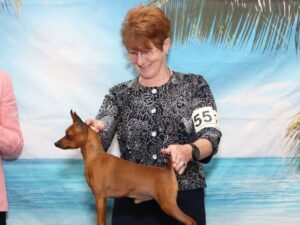
Kim Byrd | KISA Kennel
Kim Byrd is the breeder behind the KISA Kennel. Read about the kennel’s beginnings, the sires, the dams, the puppies, and much more!

Home » Dog Breeds » Basenji Dog Breed
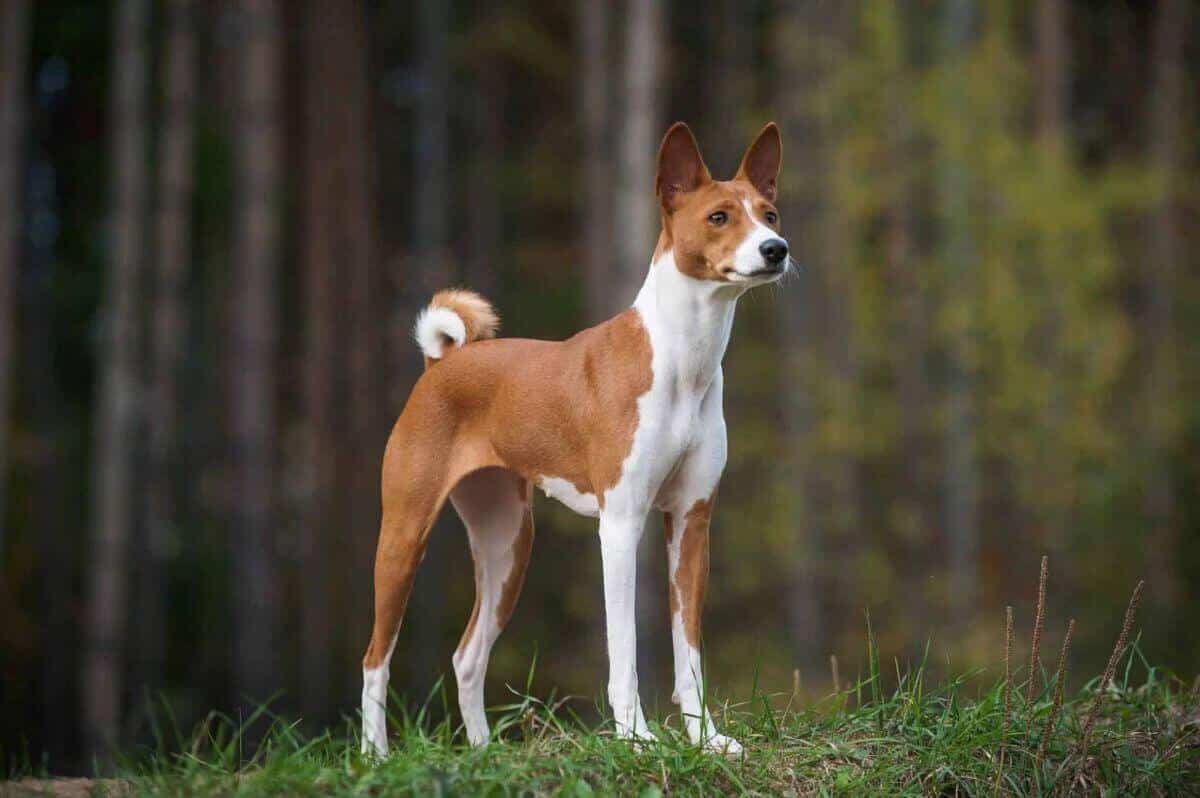
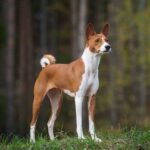
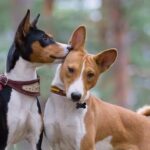

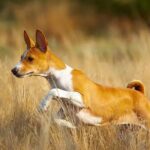
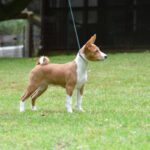
The Basenji is a unique and ancient breed, often referred to as the “barkless dog” due to the peculiar yodel-like sound it makes, known as a “barroo.” Originating from Central Africa, the breed is one of the oldest of all purebreds, having been depicted on ancient Egyptian artifacts dating from 3,000 BCE. These small hounds are elegant and athletic too, and are well-known for their keen hunting abilities and their distinctively wrinkled head.
Hound
16 – 17 Inches
22 – 24 Pounds
13 – 14 Years
| Country of Origin | Democratic Republic of the Congo |
|---|---|
| Bred For | Hunting, Companionship |
| Known For | Intelligence, Independence, Alertness |
| Popularity | Moderate |
| Temperament | Intelligent, Independent, Affectionate |
| Activities | Hiking, Running, Conformation Shows, Dog Sports |
The history of the Basenji is a tale as old as time, tracing its roots back to several ancient African civilizations. This breed, often referred to as the “barkless dog,” has captivated human societies for centuries with its unique physical characteristics and charming behavior.
Artifacts from ancient Egypt depict hound-like dogs with erect ears and tightly curled tails, bearing a striking resemblance to the modern Basenji. These depictions suggest that the dog was held in high regard by pharaohs and those of royal blood. Historical records indicate that the breed may have been brought to Egypt as gifts from Central African traders.
In its native lands, the Basenji is still primarily used for hunting, employing both sight and scent. These dogs drive prey into nets, showcasing their agility, speed, and keen senses. Their silent nature, characterized by a lack of traditional barking, is an asset during a hunt. For thousands of years, these little dogs have been employed as stealth hunters.
European explorers in the 19th century were among the first to document encounters with the Basenji. However, early attempts to introduce the breed to Europe faced many challenges, with many dogs succumbing to disease during the journey out of Africa. It wasn’t until the mid-20th century that successful breeding programs in England led to the establishment of the Basenji as a recognized breed in the Western world.
The American Kennel Club (AKC) officially recognized the Basenji in 1943, celebrating its distinct characteristics and rich heritage. The breed has also gained recognition from international canine organizations, including the Fédération Cynologique Internationale (FCI) in 1964, which further cemented its esteemed position in the purebred dog world.
Over the years, the Basenji has transitioned from being a revered hunting companion in Africa to a beloved household pet and show dog in any number of countries. The breed’s many unique charms, combined with its ancient lineage, have made these dogs an enchanting companion to many around the world.
Adult male Basenjis typically stand at a height of about 17 inches at the shoulder, while mature females are slightly smaller, standing around 16 inches tall.
In terms of weight, males generally weigh around 24 pounds, while females typically weigh about 22 pounds.
The Basenji exhibits a fine balance of proportions, appearing somewhat slightly built. The breed’s construction showcases a harmonious blend of substance and elegance. In silhouette, it appears high-on-leg, with a short back. The overall appearance reflects a well-balanced and muscular dog, agile in motion and always ready for action.
Texture: The coat of the Basenji is short and fine, giving it a sleek appearance. The texture is smooth, showcasing the dog’s graceful lines and muscular physique. The skin is thin and pliant, accentuated by the coat that is short and somewhat stiff in texture.
| Standard Color | |
|---|---|
| Black & White | ee |
| Black Tan & White | ee |
| Brindle & White | ee |
| Red & White | ee |
| Black Brindle & White | ee |
| Blue Cream & White | ee |
| Cream & White | ee |
| Mahogany Tan & White | ee |
| Sable & White | ee |
| Standard Marking | |
|---|---|
| Black Mask | ee |
| Black Saddle | ee |
| With Cap | ee |
| Brindle Markings | ee |
A Note About Color: Colors are rich and distinct, with no blending that produces muddy, grizzled, or sable coloration. Brindle-pointed tri-color dogs are acceptable. In addition to the white markings noted above, white hair may also appear on the legs and as a blaze on the head and/or as a collar on the neck.
The breed’s tail is one of its distinguishing characteristics, emphasizing the breed’s graceful and aristocratic profile. It is set high on the croup and bends forward, curling over the hip on either side. It typically forms a tight loop or a double curl, depending on the individual dog. This curled tail is a breed feature; however, the tightness of curl is less important than a high-set tail.
In terms of texture, the hair on the tail is consistent with the rest of the body, being short and fine. It’s not uncommon for the color of the tail’s coat to be a shade darker on red and white dogs. The natural curl of the tail is a vital aspect of the breed and is one of the features that gives the Basenji its unique silhouette.
Choosing to own a Basenji is a decision that brings both great joy and tremendous responsibility. As with any dog, understanding this breed’s specific needs and characteristics will facilitate a harmonious relationship between dog and owner.
The Basenji is generally a hardy breed, with a long lifespan, but like all breeds and mixed breeds, individuals can have their own health considerations.
Lifespan: On average, a Basenji can live between 13 and 14 years when given proper care and attention.
While the Basenji is generally a robust and healthy dog, it is not immune to certain health risks. Awareness of these potential conditions can guide Basenji owners to provide early intervention if needed.
In addition to being aware of these potential health risks, regular veterinary check-ups are essential for early detection. A vet can recommend specific tests for certain conditions, including annual urine tests which can be crucial for detecting Fanconi Syndrome, and eye exams for identifying the early signs of PRA.
A proactive approach to healthcare, combined with a balanced diet, regular exercise, and routine vet visits, can ensure that each Basenji lives a healthy and fulfilling life.
The Basenji is a breed full of contradictions, fusing the independence of a cat with the loyalty and affection of a typical canine. For those new to the world of dog ownership, the Basenji may present a bit of a challenge. The breed’s free-spirited nature, which can sometimes border on stubbornness, demands patience and consistent training. This trait doesn’t necessarily make these hounds the best fit for novice dog owners, who might misconstrue the Basenji’s need for autonomy as sheer defiance.
Delicate in their sensibilities, Basenjis form deep, unwavering bonds with their human families. This bond is so profound that they can be somewhat wary or reserved when first introduced to strangers. However, once a Basenji deems someone trustworthy, those early reservations often melt away, revealing a warmth that can be quite endearing.
Despite the breed’s independent streak, Basenjis don’t do well with prolonged solitude. Extended periods of being alone can trigger bouts of destructive behavior, a manifestation of their discontent and boredom. On the flip side, when it comes to other dogs, Basenjis generally play well, especially if they’ve been introduced in a friendly and controlled environment. However, their historical role as hunters means they have a pronounced prey drive. This instinctive tendency might make cohabitation with smaller pets, like cats or rodents, a bit challenging.
While children bring out the playful side of a Basenji, interactions between the two should always be supervised. The breed’s petite size and occasionally reserved demeanor can make these dogs susceptible to stress if the kids play too roughly. In households where they are introduced early and correctly, Basenjis often form cherished bonds with younger members of the family.
Feeding a Basenji requires a tailored approach, taking into consideration the dog’s age, activity level, and overall health. As puppies, nutritional needs will be distinctly different from those of adult dogs.
When Basenji puppies are in their early growth stages, they require a diet that’s rich in proteins and essential nutrients to support their rapid development. Most breeders and veterinarians would recommend a high-quality puppy food that meets these needs. As the Basenji transitions from puppyhood to adulthood, typically around the age of one year, their dietary requirements will shift. An adult Basenji will need a well-balanced diet that provides all the essential nutrients without excessive calories, which could lead to weight gain.
The amount of food a Basenji requires can vary based on several factors. Typically, an adult Basenji might consume about one to one and a half cups of dog food daily. However, this amount can fluctuate depending on the dog’s metabolism, activity level, age, and the type of food being offered. For example, a highly active Basenji might require more food than one that’s more sedentary. It’s essential, therefore, to monitor the dog’s weight and adjust the food quantity as necessary.
When considering the frequency of meals, puppies usually eat three to four times a day to support their growth. As they mature, this can be reduced to two meals a day, generally given mornings and evenings. Splitting the daily food allowance into two meals can help to maintain steady energy levels and prevent the possibility of bloat and other harmful conditions.
Regardless of age, it’s important that the Basenji always has access to fresh water throughout the day. And, as with all dogs, it’s essential to consult with a veterinarian to establish a feeding routine that’s optimal for the individual Basenji’s needs.
When it comes to training a Basenji, it’s essential to start early and approach the process with patience, consistency, and understanding. The Basenji’s independent nature, which is a notable part of the breed’s personality, also influences the dog’s approach to training. Basenjis are intelligent dogs with a streak of creativity that can sometimes be misinterpreted as stubbornness. This breed can have its own ideas about which commands or rules are essential, making traditional training methods less effective.
The key to successfully training a Basenji lies in positive reinforcement techniques. Treats, praise, and playtime can be effective motivators, helping to keep the dog engaged and eager to learn. While they have a moderate tendency to bark, it’s often more out of curiosity than aggression, and with proper training, this can be managed.
Understanding the breed’s inherent mentality is essential. Basenjis are smart dogs that enjoy mental stimulation. Incorporating puzzle games and tasks that challenge their minds can prove beneficial and makes the learning process more enjoyable for them.
A bit of wanderlust can be another characteristic of the typical Basenji. It’s important to provide these dogs with a secure environment, such as a fenced yard or leash walks, to keep their exploratory instincts in check. Early socialization is also crucial for the Basenji, so early exposure to a variety of people, pets, and experiences can help to mold a well-rounded and more sociable adult dog.
Despite their hunting instincts, Basenjis can learn to live peacefully with other household pets, especially if they are raised together. Again, early socialization plays a significant role in this, helping to minimize their natural prey drive.
Regular exercise is essential throughout a Basenji’s lifetime. These energetic dogs possess a zest for life that needs a proper outlet to encourage good overall health, both mentally and physically. These dogs exhibit a moderate to high energy level, which means they’ll thrive on routine activity and engagement.
| Energy Level | Moderate to High |
|---|---|
| Exercise Requirements | 2 Hours/Day (Minimum), Daily Walks, Vigorous Running, Regular Exercise, Playing with Another Dog, Mental Stimulation |
Their historical role as hunting dogs in Africa has gifted the Basenji with a stamina that demands more than just a leisurely walk around the block. Regular, brisk walks, combined with enthusiastic play sessions, are recommended for this breed. Basenjis typically enjoy interesting activities that challenge their body, mind and spirit. Games like fetch, hide-and-seek, and even running agility courses can be particularly enjoyable for them.
Intensity is another factor to consider in the Basenji’s exercise routine. While they have bursts of high energy, they also appreciate a little downtime to recharge. After a good play session or walk, it’s not at all unusual to find a Basenji lounging comfortably, savoring a well-deserved rest.
Despite their energy levels, Basenjis are also known for their playful demeanor. They can be quite the entertainers, often indulging in playful antics that can be both endearing and amusing to watch. Engaging with them in interactive games can not only provide the exercise they need, it can also strengthen the bond between dog and owner.
However, the Basenji’s inherent desire to run means that it’s vital to have a secure area whenever they play off-leash. A fenced yard is ideal, ensuring the dog doesn’t chase after a squirrel or some other enticing little creature.
The Basenji’s sleek and fine coat offers a certain ease when it comes to grooming. The breed’s short hair is easy to care for, and like cats, these dogs have a natural tendency to keep themselves clean. This simplicity when it comes to grooming is one of the breed’s many appealing characteristics.
| Coat Type | Short, Fine |
|---|---|
| Grooming Requirements | Weekly Brushing, Occasional Bathing, Routine Ear Cleaning, Periodic Nail Trimming, Regular Tooth Brushing |
That said, regular coat care is still beneficial for the dog’s overall well-being. A weekly brushing with a soft-bristle brush or grooming mitt will help to remove any loose hairs and will keep the coat looking its best. This routine also promotes healthy skin by distributing the natural oils evenly throughout the coat, adding a glossy sheen.
One of the unique aspects of the Basenji is that these dogs don’t have the typical doggy odor. Their general cleanliness contributes to this, making them particularly suitable for individuals who are sensitive to pet odors. And although they might not require frequent baths, it is advisable to bathe them when they get particularly dirty or if they’ve rolled in something unpleasant. A mild dog shampoo is all that’s recommended to maintain the coat’s natural oils and prevent minor skin irritations.
Other facets of grooming, such as nail trimming, ear cleaning, and dental care, follow the general guidelines for most dog breeds. Regular inspection of the Basenji’s ears for signs of wax buildup, redness, or irritation, and cleaning as necessary, can help to prevent infections from occurring. Dental hygiene is also essential, so brushing the teeth several times a week will keep dental diseases at bay.
One of the lesser-known traits of the Basenji is that the breed is among those that shed minimally. While no dog is entirely hypoallergenic, this hound comes close, making it a good choice for those with mild pet allergies.
Adapting one’s life to accommodate a Basenji can be a joyful learning experience. This ancient breed, with its unique quirks and independent demeanor, requires specific considerations when it comes to the dog’s living environment.
Firstly, the Basenji is an adaptable dog that can comfortably live in an apartment, provided the dog’s exercise needs are met. The breed’s moderate size and quiet nature (in terms of barking) makes these dogs well-suitable for apartment living. However, owing to their high energy levels and inherent curiosity, it’s essential to provide them with adequate physical and mental stimulation daily to prevent potential behavioral problems.
In terms of weather adaptability, the breed’s short coat is best suited for warmer climates, reminiscent of its origins in Central Africa. This doesn’t mean Basenjis can’t tolerate colder weather, but in areas with harsh winters, extra care is necessary. Protective clothing, or limiting exposure during extreme cold spells, are the best safeguard options. Conversely, in hot weather, it’s important to prevent overheating and ensure they have access to shade and plenty of water, especially following outdoor activities.
The Basenji’s intelligence, combined with the breed’s penchant for mischief, often leads these dogs to find creative ways to entertain themselves. Whether it’s figuring out how to open doors or indulging in a bit of harmless counter-surfing, their surroundings should be Basenji-proofed to guarantee their safety. Secure fencing in outdoor areas is crucial, given their surprising climbing abilities and tendency to run.
Harmoniously living with a Basenji also means understanding and respecting the dog’s independence. While these dogs form strong bonds with their families and can be remarkably affectionate, they can also cherish their alone time. A balance between engagement and giving them their space is key to a harmonious household.
The sight of a Basenji puppy, with its curious wrinkles and playful demeanor, can captivate just about anyone. These little bundles of energy are not just adorable, however, they’re also a testament to the breed’s ancient lineage. Raising one of these intelligent and affectionate hounds requires dedication, understanding, and proper care to allow the pup to mature into a well-rounded adult.
From the moment a Basenji puppy steps into its new home, it’s essential to set the right foundation for its development. One of the primary considerations is nutrition. Providing a balanced diet specifically formulated for puppies will support the little one’s rapid growth and ensure it receives all the essential nutrients. As it grows, monitoring the puppy’s weight and adjusting its food intake accordingly will help to maintain optimal health throughout the first year.
Socialization is another pivotal aspect of puppy care. Exposing the young Basenji to various environments, sounds, people, and other animals during the early months will help the puppy become a more adaptable and confident adult. Positive experiences during this critical period can shape behavior that carries into adulthood.
Training should start early, given the breed’s independent nature. While Basenjis are intelligent and quick learners, their self-determination can sometimes be a challenge. Consistent, positive reinforcement methods, combined with endless reserves of patience, are key to successful training sessions. Housebreaking, basic commands, and leash training should be introduced during the puppy months.
Health check-ups play a crucial role toward ensuring the puppy’s well-being. Regular visits to see the vet for vaccinations, deworming, and general health assessments will provide a solid foundation for a long and healthy life.
Basenji puppies, with their boundless energy, require safe toys and play areas. It’s important to remember that chewing is a natural behavior for puppies. So, providing chew toys can not only keep them entertained, it will also help with teething and prevent the destruction of shoes, rugs, and fingertips!
Lastly, it’s important to remember that while Basenji puppies are resilient, they can also be delicate. Care should be taken to make sure they don’t overexert themselves or get exposed to potentially harmful environments or situations.
The innate agility, sharp senses, and intelligence of the Basenji makes these dogs adept at a multitude of activities and dog sports. The breed’s deep-rooted hunting and tracking heritage manifests in the dogs’ enthusiasm for various pursuits. Engaging them in these avenues not only caters to their physical needs, it also provides essential mental stimulation.
Outside of these formal sports, Basenjis also relish simple recreational activities such as fetch, hide-and-seek, and free play in open spaces.
In essence, the diverse array of activities and dog sports available to the Basenji can help to offer physical fitness, mental stimulation, and a deep bond with their human companions.
The Basenji is recognized by the world’s leading registries and kennel organizations, which categorize the breed into a specific Group based on its unique characteristics. This breed is recognized worldwide under the following Group designations:
| Organization | Group Designation |
|---|---|
| AKC (American Kennel Club) | Hound |
| UKC (United Kennel Club) | Sighthound and Pariah Dog |
| CKC (Canadian Kennel Club) | Hounds |
| ANKC (Australian National Kennel Council) | Hounds |
| RKC (The Royal Kennel Club) | Hound |
| FCI (Fédération Cynologique Internationale) | Group 5: Spitz and Primitive Types; Section 6: Primitive Type |
The ideal Basenji is described by a Breed Standard that is approved by each of the world’s leading registries and kennel organizations. The Breed Standards for this breed may be found in the following links:
| Organization | Breed Standard |
|---|---|
| American Kennel Club | AKC Basenji Breed Standard |
| United Kennel Club | UKC Basenji Breed Standard |
| Canadian Kennel Club | CKC Basenji Breed Standard |
| Australian National Kennel Council | ANKC Basenji Breed Standard |
| The Royal Kennel Club | RKC Basenji Breed Standard |
| Fédération Cynologique Internationale | FCI Basenji Breed Standard |
Breed clubs play an instrumental role in preserving, promoting, and celebrating the unique qualities of a particular dog breed. For the Basenji, several breed clubs have been established across different countries, championing the breed’s interests, setting breeding standards, and hosting events to bring Basenji enthusiasts together.
In the United States, the Basenji Club of America (BCOA) stands as the primary organization dedicated to the breed. Established in the mid-20th century, shortly after the Basenji’s recognition by the American Kennel Club, the BCOA has been pivotal in promoting the breed’s interests, supporting ethical breeding practices, and organizing show and social events.
Canada boasts the Basenji Club of Canada (BCC). The BCC dedicates itself to the promotion and betterment of the Basenji, providing resources for breeders and owners alike and ensuring the breed’s rich legacy continues in that country.
In the United Kingdom, the Basenji Club of Great Britain serves as the breed’s leading advocate. Given the UK’s integral role in introducing the Basenji to the Western world during the 20th century, this club has a storied history and remains active in safeguarding the breed’s interests, setting high standards for care and breeding, and organizing events that celebrate the Basenji’s unique attributes.
While the Basenji is a cherished breed with a rich history, there are instances when these dogs can find themselves in need of new homes. Whether due to changes in family circumstances, abandonment, or other unfortunate situations, rescue organizations play a pivotal role in providing a lifeline for these dogs, ensuring they find loving, forever homes.
In the United States, the Basenji Rescue and Transport (BRAT) stands out as a significant organization dedicated to rescuing, rehabilitating, and rehoming Basenjis in need. Through the efforts of dedicated volunteers, BRAT offers rescue services across the country, providing vulnerable Basenjis with proper care and suitable homes.
The Basenji Club of Canada takes a proactive role in the welfare of the breed in Canada. The club has its own rescue program dedicated to assisting Basenjis in need. They work diligently to ensure that any Basenji that requires rehoming gets the appropriate care and is matched with a loving family that understands the breed’s unique characteristics and needs.
Similarly, in the United Kingdom, the Basenji Club of Great Britain is at the forefront of rescue efforts for the breed. Through collaborations with shelters, breeders, and the general public, the club makes sure that any Basenji in need is given a second chance at a happy life.
It’s also worth noting that local animal shelters and rescue organizations can occasionally have a Basenji available for adoption. Prospective adopters are encouraged to explore these avenues when considering bringing a Basenji into their lives.
Yes, Basenjis shed, but typically much less so than many other dog breeds. They have a fine, short coat that requires minimal grooming. But while their shedding is minimal, regular brushing can help to keep their coat healthy and further reduce loose hairs around the house.
No breed is truly hypoallergenic, but Basenjis are often recommended for people with mild allergies due to their low shedding and lack of a typical dog odor. However, potential dog owners with allergies should spend time with a Basenji before deciding to get one to make sure no allergic reactions occur.
Basenjis are known as the “barkless dog.” While they don’t bark in the typical sense, they do make a unique yodel-like sound called a “barroo.” This vocalization is distinct to the breed and is different from the common dog bark.
Basenjis typically have a lifespan of 13 to 14 years, though some can live even longer with proper care. Regular veterinary check-ups, a balanced diet, and adequate exercise contribute to their longevity.
Basenjis are a medium-sized breed. Male Basenjis typically stand at a height of about 17 inches at the shoulder, while females are slightly smaller, standing around 16 inches tall. In terms of weight, males generally weigh around 24 pounds, with females typically weighing around 22 pounds.
Basenjis are not inherently aggressive, but they are known for their strong hunting instincts and aloof interactions with strangers. Proper socialization from a young age and consistent training can prevent most unwanted behaviors. It’s essential to understand their basic temperament and social needs to ensure harmonious interactions with other animals and humans.
As with the previous question, Basenjis are not naturally aggressive. However, their hunting background means they have a strong prey drive. This shouldn’t translate into aggression towards humans, but it does mean they might chase smaller animals. Proper training and socialization are a must.
Basenjis are intelligent and independent, which can sometimes be mistaken for stubbornness. This means that while they can learn quickly, they also need a consistent and patient trainer. Positive reinforcement techniques tend to work best with this breed, and early socialization is key to developing a well-rounded adult dog.

Kim Byrd is the breeder behind the KISA Kennel. Read about the kennel’s beginnings, the sires, the dams, the puppies, and much more!
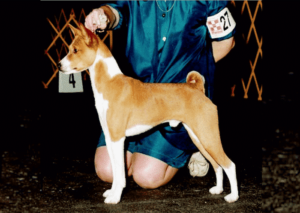
Unlock the secrets of judging the Basenji breed with our comprehensive guide. Learn about traits, standards, and unique quirks. Read more..
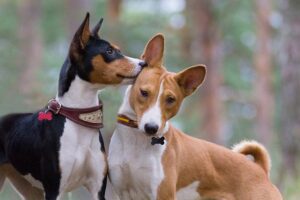
Learn how the colors originated and changed through time, and see what are considered rare and what standard Basenji colors and markings.

Interview with Hound Group Breeder Heather Galford – My kennel name is HighGard, and we currently have eight dogs; six Basenjis and two
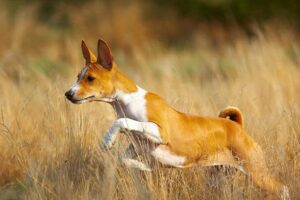
Interview with Hound Group Breeders Brenda & Ciara Cassell – Signet Kennels – We are located outside of Fort Worth, Texas. I am a
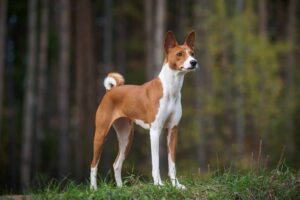
Now, as a relative old-timer, I think of “Basenji square” as being much like “Norwegian Elkhound” square. Thus, I like a compact little dog
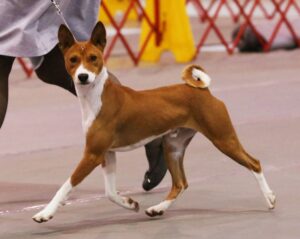
Proportionally Speaking: The Square Basenji | Having found myself, accidentally, the President of the Basenji Club of America back in 1989, I was dropped into the middle of a controversy about the revision of our Standard.
The best way to ensure a long and happy relationship with a purebred dog is to purchase one from a responsible breeder. Not sure where to begin?
Contact the National Parent Club’s Breeder Referral Program, which is listed on the AKC Breeder Referral Contacts page.
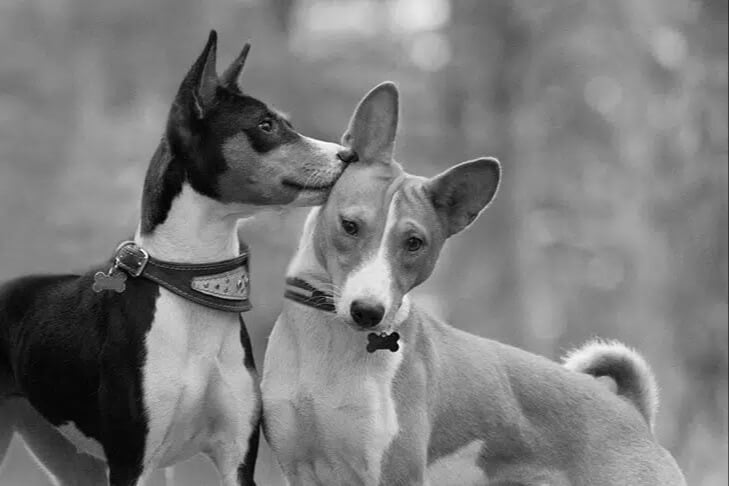

"*" indicates required fields
Showsight Magazine–the world’s most influential purebred dog publication since 1992. Each issue reaches a global audience dedicated to preserving the history and health of purpose bred dogs. Filled with award-winning editorial focused on news and insights from the dog show community, top breeders, handlers, AKC Judges, and more!